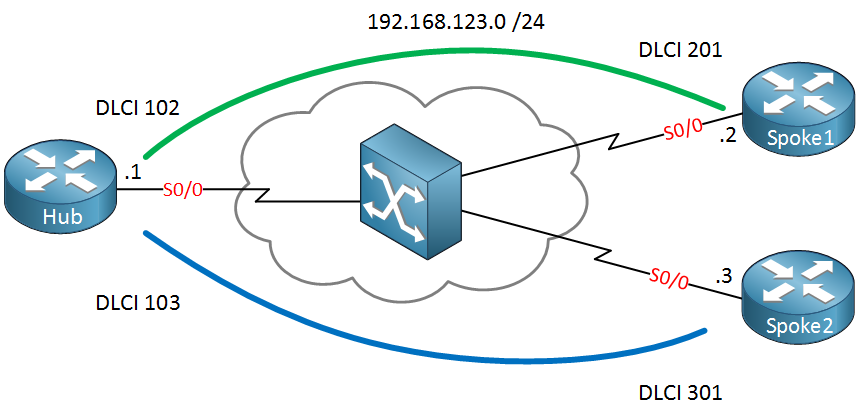The different OSPF network types are a pain to understand for most students. I’m going to cover all of them in a series of lessons and in this one, we’ll take a look at the OSPF non-broadcast network type. We will be using a point-to-multipoint frame-relay network for the demonstration:

If you select the non-broadcast network type, then OSPF will assume you are running a non-broadcast multi-access (NBMA) network. Here are a couple of key things to remember here:
- Multi-access means we have to select a DR and BDR.
- Non-broadcast means that OSPF expects us to configure neighbors ourselves.
Now look closely at my frame-relay network in the picture above and assume we will run the non-broadcast network type here. Is my network multi-access? Interesting question, right?
Is there any connectivity between routers Spoke1 and Spoke2? You can see I only have 2 PVCs, and there is no connection between Spoke1 and Spoke2. This is where things can get funky! If we select the non-broadcast network type we are telling OSPF our network is multi-access, but in reality, it’s not…there is only connectivity between the Hub router and the Spoke routers, not between the 2 spoke routers.
When I explained the DR/BDR to you, I told you that we only have a full adjacency with the DR/BDR and not with all other routers. What do you think will happen if Spoke1 is elected as the DR?
Since Spoke2 can’t reach Spoke1, it can never set up a full OSPF neighbor adjacency, and we’ll run into connectivity issues. How do we solve this? We have to make sure the Hub router becomes the DR, and Spoke1 or Spoke2 will never become DR or BDR!
The Hub router can be reached by Spoke1 and Spoke2, so if it’s the DR, they can do the full OSPF neighbor adjacency, exchange routing information, and life is all good. Let’s take a look at the configuration:
Hub(config)#interface serial 0/0
Hub(config-if)#ip address 192.168.123.1 255.255.255.0
Hub(config-if)#encapsulation frame-relay
Hub(config-if)#ip ospf network non-broadcast
Hub(config-if)#exit
Hub(config)#router ospf 1
Hub(config-router)#network 192.168.123.0 0.0.0.255 area 0
Hub(config-router)#neighbor 192.168.123.2
Hub(config-router)#neighbor 192.168.123.3Here is the configuration of the Hub router. I used the ip ospf network non-broadcast command to change the OSPF network type. I also had to specify the neighbors, so OSPF switches to unicast.
Spoke1(config)#interface serial 0/0
Spoke1(config-if)#ip address 192.168.123.2 255.255.255.0
Spoke1(config-if)#encapsulation frame-relay
Spoke1(config-if)#ip ospf network non-broadcast
Spoke1(config-if)#ip ospf priority 0
Spoke1(config-if)#exit
Spoke1(config)#router ospf 1
Spoke1(config-router)#network 192.168.123.0 0.0.0.255 area 0Spoke2(config)#interface serial 0/0
Spoke2(config-if)#ip address 192.168.123.3 255.255.255.0
Spoke2(config-if)#encapsulation frame-relay
Spoke2(config-if)#ip ospf network non-broadcast
Spoke2(config-if)#ip ospf priority 0
Spoke2(config-if)#exit
Spoke2(config)#router ospf 1
Spoke2(config-router)#network 192.168.123.0 0.0.0.255 area 0Here is the configuration of the spoke routers. I changed the OSPF network type as well, but there’s one little extra. See the ip ospf priority 0? That’s how you ensure these routers will never become a DR or BDR.
Make sure you have a frame-relay map statement with the broadcast keyword, or you won’t be able to send multicast on your frame-relay network. By default Inverse ARP is enabled and will do this for you…if you don’t have inverse ARP, make sure you add it!
Hub#show ip ospf neighbor
Neighbor ID Pri State Dead Time Address Interface
192.168.123.2 0 FULL/DROTHER 00:00:30 192.168.123.2 Serial0/0
192.168.123.3 0 FULL/DROTHER 00:00:35 192.168.123.3 Serial0/0Here you can see that the hub router is the DR because the spoke routers are DROTHERS.
Unit 1: Introduction to OSPF
- Introduction to OSPF
- Basic OSPF Configuration
- OSPF Multi Area Configuration
- OSPF Reference Bandwidth
- OSPF Plain Text Authentication
- OSPF MD5 Authentication
- OSPF SHA-HMAC Authentication
- OSPF TTL Security Check
- OSPF Default Route
Unit 2: OSPF Neighbor Adjacency
- OSPF LSA Types
- OSPF LSAs and LSDB Flooding
- OSPF Hello and Dead Interval
- OSPF Router ID
- OSPF Packets and Neighbor Discovery
- OSPF DR/BDR Election
- OSPF Passive Interface
- Troubleshooting OSPF Neighbor Adjacency
Unit 3: OSPF Network Types
- OSPF Non-Broadcast Network Type
- OSPF Broadcast Network Type
- OSPF Point-to-Multipoint Network Type
- OSPF Point-to-Multipoint Non-Broadcast Network Type
- OSPF Point-to-Point Network Type
- OSPF Next Hop with Network Types
Unit 4: OSPF Stub Areas
- Introduction to OSPF Stub Areas
- How to configure OSPF Stub Area
- How to configure OSPF Totally Stub
- How to configure OSPF NSSA (Not So Stubby) Area
- How to configure OSPF Totally NSSA (Not So Stubby) Area
- OSPF NSSA P-bit explained
Unit 5: Advanced OSPF Topics
- OSPF Summarization
- OSPF Distribute-List Filtering
- OSPF LSA Type 3 Filtering
- OSPF LSA Type 5 Filtering
- OSPF Virtual Link
- OSPF Virtual Link Authentication
- OSPF Path Selection Explained
- How to read the OSPF Database
- OSPFv3 for IPv4
- Troubleshooting OSPF Route Advertisement
- OSPF SPF Scheduling and Throttling
- OSPF LSA Throttling
- OSPF Incremental SPF
- OSPF Prefix Suppression
- OSPF Stub Router
- OSPF Graceful Shutdown
- OSPF Graceful Restart
- OSPF Loop-Free Alternate (LFA) Fast Reroute (FRR)
- OSPF Remote Loop-Free Alternate (LFA) Fast Reroute (FRR)